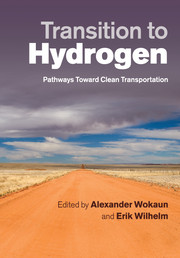Book contents
- Frontmatter
- Contents
- Contributors
- Foreword: on the transition to hydrogen
- Preface
- Executive summary
- Abbreviations
- 1 Introduction
- 2 Life cycle assessment of hydrogen production
- 3 Technical characterisation and multi-criteria analysis of light-duty vehicles
- 4 Hydrogen emissions to the atmosphere from industry and transportation
- 5 Regional fleet simulation
- 6 Long-term scenarios of the global energy and transport system
- 7 Integrated assessment of hydrogen in transportation
- Appendix A Summary of fundamental assumptions
- Appendix B Selected input assumptions, technology descriptions, and heuristics
- Appendix C Characteristics of the present and future vehicle designs
- Appendix D Survey questionnaire and aggregated responses
- Appendix E Assumptions and inputs driving fleet dynamics simulation
- References
- Index
- Plates
Appendix E - Assumptions and inputs driving fleet dynamics simulation
Published online by Cambridge University Press: 05 November 2011
- Frontmatter
- Contents
- Contributors
- Foreword: on the transition to hydrogen
- Preface
- Executive summary
- Abbreviations
- 1 Introduction
- 2 Life cycle assessment of hydrogen production
- 3 Technical characterisation and multi-criteria analysis of light-duty vehicles
- 4 Hydrogen emissions to the atmosphere from industry and transportation
- 5 Regional fleet simulation
- 6 Long-term scenarios of the global energy and transport system
- 7 Integrated assessment of hydrogen in transportation
- Appendix A Summary of fundamental assumptions
- Appendix B Selected input assumptions, technology descriptions, and heuristics
- Appendix C Characteristics of the present and future vehicle designs
- Appendix D Survey questionnaire and aggregated responses
- Appendix E Assumptions and inputs driving fleet dynamics simulation
- References
- Index
- Plates
Summary
The development of the vehicle fleet in the selected countries was estimated regarding their demographic and economic perspectives. Recent predictions by Alho et al. (2006) are that the population size in the European Economic Area (EEA) including Switzerland will increase slightly from the current level of 392 million to 427 million inhabitants by 2050. This median scenario by Alho et al. (2006) was chosen as the basis for the estimation of the fleet sizes for the first half of the twenty-first century, followed by a slight decrease from 2050 to 2100. This has been complemented by data from the Council of Europe (2005) on the population increase between 1995 and 2004, where Germany, Italy, Great Britain, Sweden, and Poland show a 0% increase, France and Switzerland between 2% and 5%, and Spain between 6% and 10%.
The economic aspect of the development is represented by the GDP, which shows the increase in value of all final goods and services produced within a nation in a given year (not taking into account purchasing power parity but taking into account inflation). It is used as a measure of economic development. The values are taken from the World Factbook (CIA, 2008). The computed fleet sizes are a result of data-deduced growth curves and take the values shown in Figure E.1.
- Type
- Chapter
- Information
- Transition to HydrogenPathways Toward Clean Transportation, pp. 230 - 234Publisher: Cambridge University PressPrint publication year: 2011



